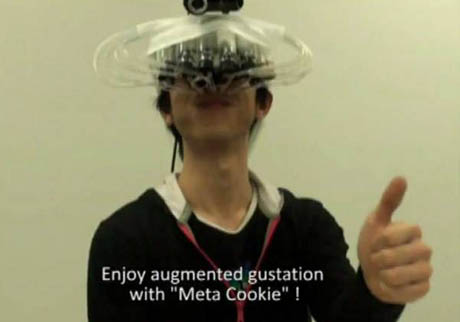This September, Tim Maly of Quiet Babylon is curating a month-long 50th birthday party for the word “cyborg.”

IMAGE: A cyborg mouse, depicted in Clynes and Kline’s paper, “Cyborgs and Space,” published in Astronautics magazine, September 1960: “One of the first Cyborgs, this 220-gm rat has under its skin the Rose osmotic pump, designed to permit continuous injections of chemicals at a slow, controlled rate into an organism without any attention on the part of the organism.”
In his highly readable introduction to the project, Maly explains that the term was coined by two scientists in September 1960, in response to the pressing contemporary question of how man could survive in space:
One solution is architectural.
Using the latest construction techniques, you can build a little bubble of earth, and plunk it down on any old alien world. We can send people off to these environments and so long as the walls don’t burst and the air doesn’t run out, they’ve got all the comforts of home.
A pair of scientists, Manfred Clynes and Nathan Kline, had a different idea.
“What if we could just live in space?” they asked, “What if instead of adapting the environment to ourselves, we adapted ourselves to the environment?”
To do that, they reasoned, you need a cybernetic feedback system to maintain homeostasis unconsciously. These systems need to become a part of the organism. A cybernetic organism. A Cyborg.
In other words, through the incorporation of a synthetic, “non-human” technological bridge, Clynes and Kline proposed that atmosphere-dependent humans could be transformed into happy, healthy, galaxy-wandering cyborgs.

IMAGE: David Kessler, as seen in the video trailer for The End of Overeating
With that definition of a cyborg floating around in the back of my mind, a few weeks ago, I started following @DavidAKesslerMD on Twitter. Kessler served as head of the U.S Food and Drug Administration for seven years in the 1990s, and is the author of a new book, The End Of Overeating: Taking Control Of The Insatiable American Appetite. His oracular tweets are addressed to a nation hijacked by junk food, its populace enslaved by chemical concoctions our neurons can’t resist and immersed in an environment designed to hyperstimulate.

IMAGE: Tweets by @DavidAKesslerMD
Kessler blames the food industry for consciously designing foods and foodscapes that are hostile to human health. For thousands of people, as he explained to Gourmet, America’s obesogenic environment actually short circuits normal homeostatic regulation:
For most of us, the reward centers of our brain have so overpowered the homeostatic mechanisms that we don’t even feel satiation. At least for the tens of millions of people who have conditioned hypereating.
Children ages two to five used to be able to compensate for calories: If you fed them more calories [than they typically ate in one meal], they would eat less later on. But now, by the age of five, that compensation is gone; they’re just eating for reward all the time. There are children who are age five and younger who have never been hungry in their lives.

IMAGE: Still from the video trailer for Kessler’s book, The End of Overeating.

IMAGE: Still from the video trailer for Kessler’s book, The End of Overeating.
Kessler’s solutions are more familiar in tone: he advocates public education campaigns and policy tweaks designed to empower America’s 70 million conditioned hypereaters to seize control, consciously avoid food cues, and re-programme their hijacked neurons.

IMAGE: Still from the video trailer for Kessler’s book, The End of Overeating.
But what if, instead, we likened the hostile American foodscape to outer space, and approached the problem cyborgically?
Could we, like Manfred Clynes and Nathan Kline, imagine a synthetic technology that could be incorporated into humans in order to create physiological changes that enable us to remain healthy while surrounded by the lethal landscape of processed food?

IMAGE: Lap band technology.
Perhaps we already have — after all, isn’t everyone with a lap-band actually a cyborg, reliant on a stomach-reshaping silicone tube to experience satiety and maintain a healthy weight in a world that contains deep-fried butter?

IMAGE: Deep-fried butter at the Texas State Fair. Photo by cmiked, via Flickr.
Nonetheless, today, as Tim Maly notes, most people equate the term cyborg with “chromed man-machine monsters – your Terminators, Robocops, and Ghosts in the Shell.” Along these lines, we might consider the MetaCookie.

IMAGE: Still from a New Scientist video introducing the Meta-Cookie.
Invented by Japanese scientist Tajuki Narumi at the University of Tokyo, MetaCookie is a head-mounted “augmented gustation” technology that allows its cyborg host to enhance a plain cookie with the flavour of their choice. According to New Scientist:
To create the effect, the team branded a plain cookie with a distinct logo that the headset tracks via a built-in camera. An air pump sprays out the smell of the chosen cookie, increasing its concentration as the system “sees” the cookie approaching the wearer’s nose.
Meanwhile, a visual display in the headset shows an image of the chosen cookie, suggesting the correct texture for that flavour.
The combination of smell and visual texture combine to fool the user’s sense of taste into thinking they are eating a flavoured cookie instead of the plain one.

IMAGE: Still from a New Scientist video introducing the Meta-Cookie.
From these Willy Wonka beginnings, it’s just a short step to imagine millions of trim, healthy, American cyborgs inhaling apple slices as if they were French Fries, their visual and olfactory receptors subtly reconfigured by the MetaCookie technology to permit unconscious biological adaptation to a dangerously obesogenic environment.

IMAGE: Still from a New Scientist video introducing the Meta-Cookie.
[NOTE: For more fiftieth-anniversary-inspired cyborg riffs, including cyborg orchards, cyborg theology, and cyborg cooking, visit 50 Posts About Cyborgs.]

